Plantation Crops | Geography for UPSC CSE PDF Download
PLANTATION CROPS
- Tea (Camellia thea)
- Coffee (Coffea)
- Rubber (Hevea brasiliensis)
- Pepper (Piper nigrum)
- Cardamom (Elettaria cardamomum)
- Chillies (Capsicum annum)
- Turmeric (Curcuma longa)
- Ginger (Zingiber officinale)
- Coconut (Cocos Nucifera)
- Arecanut (Areca catechu)
- Cashewnut (Anacardium occidentale)
TEA (Camellia thea)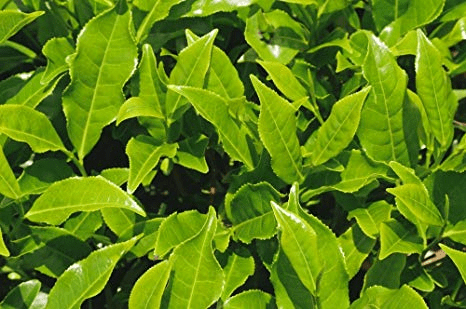
Tea is the most favorite beverage because it acts as a tranquilliser and mild stimulant. India is the world's largest producer and exporter of tea accounting for 34 and 24 percent of the fourth largest in export volume total in these respectively. Sri Lanka exports 95 percent production and ranks first.
Conditions of Growth: Tea plant is native of the Yamuna plateau of southern China and the hills of Purvanchal. The plant thrives well in all humid climate areas on hill slopes where the annual rainfall is heavy, 150-250 cm, and uniformly distributed. It cannot stand long dry spells and a temperature below 100C.
It is a shade-loving plant and develops well under light shade. High humidity, heavy dew and morning fog favor the plant growth. Wheel drained, deep friable looms or forest soils should be rolling so as to prevent water-logging. Application of nitrogenous fertilisers to the soil periodically increases the yield of plant.
Cultivation: Tea plant is cultivated on cleared hill slopes under shade trees like silver oak. It is generally propagated from seeds, but recently the use of high yielding clonal material has become popular. The plants are initially raised in nurseries which are then transplanted in permanent garden sites. The garden is weeded and the plants are pruned regularly which heaps in higher yields. Two main varieties of tea cultivated in India are the small leaved Chinese (bohea) and the large leaved Assamese (assamica).
Processing: Best tea is obtained by plucking only the terminal bud and two leaves, called fine plucking. In coarse plucking more leaves are plucked. Bulk of the Indian tea is processed into black variety and small amount into green variety. The production of black variety tea involves withering, fermenting, drying and grading, whereas, green tea is produced without involving fermentation.
Distribution: Assam is largest tea producer in India followed by West Bengal, Tamil Nadu and Kerala. The other producers are Karnataka, Tripura, Himachal Pradesh and Uttar Pradesh.
COFFEE (Coffea)
India produces only 3.2 percent of world's production but her coffee being of mild variety is very popular. India ranks sixth in world coffee production. CoffeaConditions of Growth: Coffee plant requires a warm and humid climate with 150-200 cm rainfall and 15-300C temperatures. Strong sunshine and frost both are harmful to plant. Dry weather for proper ripening of the beans is necessary in December and January.
CoffeaConditions of Growth: Coffee plant requires a warm and humid climate with 150-200 cm rainfall and 15-300C temperatures. Strong sunshine and frost both are harmful to plant. Dry weather for proper ripening of the beans is necessary in December and January.
Generally, coffee is grown on slopes having height between 600 to 1,800 metres with rich well-drained friable loams sloping gently towards north or east are ideal for coffee plantations. Coffee plants are normally laid out on terraced slopes with shade trees like silver oak raised in advance.
The two main varieties of coffee grown in India are:
Arabica, which produces the finest coffee, and Robusta accounting for 49 percent and 51 percent of area respectively.
Plucking and Processing: Coffee plants start bearing beans during the third or fourth year and continue up to 50 years. The beans ripen in 8-9 months and are then plucked. These are then processed either by dry or wet method. In the former method seeds are removed from beans by sun drying while the second method involves pulping, fermentation, washing, drying and peeling with the help of equipment and machinery. Large estates generally use wet method and coffee produced is called 'plantation' or 'parchment' coffee. While the coffee produced by dry method is called 'cherry' or 'native'.
Distribution: Karnataka, Kerala and Tamil Nadu account for almost entire area and production of coffee in India. Karnataka dominates with 53 percent of the total coffee production. Coorg and Chikmagalur are the major areas of the state producing coffee. In Tamil Nadu (9% of total production) 50% of the coffee is mainly raised in Nilgiri district and the rest 50% in Madurai, Tirunelveli and Coimbatore districts. In Kerala (15% of country's total output) coffee is raised in Kozhikode, Cannore and Palghat districts.
Area, Production and Yield: The area and production of coffee which was 0.1 million hectares and 0.04 million tonnes respectively in 1960-61 has increased to 0.3 million hectares and 0.2 million tonnes respectively in 1995-96.
Consumption and Trade: Nearly 25 percent of the coffee produced in India is consumed in the country, mostly in the three producing states of Karnataka, Kerala, and Tamil Nadu. The per capita consumption of coffee was 80 gm in 1960-61 and 67 gm in 1994-95. The internal consumption was 53 thousand tonnes or 24 percent of the total production (2.23 lakh tonnes) in the year 1995-96. The internal consumption was 53 thousand tonnes or 24 percent of the total production (2.23 lakh tonnes) in the year 1995-96. The production coffee in 2003-04 was 275 thousand tonnes.
The quantity and value of coffee exports is increasing in recent years. In 1960-61 the quantity and value of coffee exported was 19.7 thousand tonnes and Rs. 7 crore respectively, whereas the corresponding figures for 1995-96 are 170 thousand tonnes (76 percent of total output) and Rs. 1,524 crore respectively. Out of 2.65 lakh tonnes output during 1998-99 over to percent was exported valued at Rs. 1703 crore.
India accounts for only about one per cent of the total world exports of coffee. Nevertheless, Indian coffee is well-known for its quality in the foreign markets. Europe has been the main market for India coffee and its share has been the main market for Indian coffee and its share has been uniformly high.
RUBBER (Hevea brasiliensis)
India ranks fifth amongst the rubber producing countries in the world. It account for about 2.5 percent of the world production. Country's demand for natural rubber is largely met by indigenous production, with only a small proportion (less than 5 per cent) met through imports. 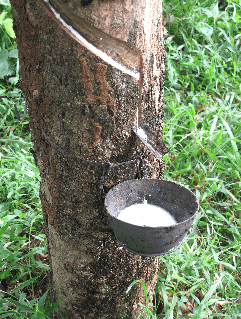 Hevea brasiliensisConditions of Growth: The rubber plant requires well-distributed rainfall of about 300-400 cm and a temperature range of 25-350. Humid weather throughout the year is ideal whereas long droughts are injurious to the plant. Rubber thrives best on deep well-drained loamy soils. It is grown on hill slopes up to the height of about 300 meters, like on the slopes of western and eastern ghats. At higher elevation growth and yields decline.
Hevea brasiliensisConditions of Growth: The rubber plant requires well-distributed rainfall of about 300-400 cm and a temperature range of 25-350. Humid weather throughout the year is ideal whereas long droughts are injurious to the plant. Rubber thrives best on deep well-drained loamy soils. It is grown on hill slopes up to the height of about 300 meters, like on the slopes of western and eastern ghats. At higher elevation growth and yields decline.
Almost all the plantations in Kerala are found between 300 and 700 meters.
Seeds first germinated on riverbed sands are transferred to specially prepared nursery beds from where they are shifted to permanent sites in plantations when they are about 2.5 cm in diameter each. Rubber is also propagated by vegetative means using buds of selected mother clones. Constant tending and manuring is required for good growth yield of rubber tree.
Tapping Latex and Processing: Latex, a whitish or yellowish milk like substance, flows from the bark of lower part the rubber tree when cut. Latex (containing 33 percent dry rubber) is then collected, cleaned, mixed with acetic acid and heated on slow heat for 24 hours which converts it into a coagulated soft whitish mass. The coagulated mass is then rolled into sheets, cleaned in water and dried to get ready-to-use rubber.
Distribution: Kerala, the major rubber producing state, together with Tamil Nadu accounts for 86 percent of total area under rubber. It contributes over 75 percent of total rubber production. The other rubber producing state are Maharashtra, Tripura, Meghalaya, Mizoram, Manipur, Assam, Nagaland, Andaman and Nicobar Island, Goa etc. Most plantations are raised on small and average holdings.
PEPPER (Piper nigrum)
India is the second largest producer of pepper after Indonesia. India contributes about 50 percent of the world's total production. The black pepper is the unripe dried fruit while the skinned ripe fruit is the white pepper, which like other spices, is used for flavoring foodstuffs. 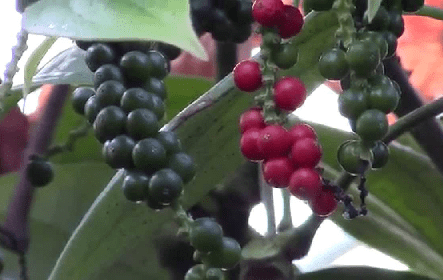 Pipper nigrum The plant, a tropical crop, requires a hot and humid climate with 150-200 cm or more annual rainfall and 10-300 temperatures. It is grown on hill slopes up to 1,200 metres above mean sea level. It thrives well on deep, friable, well-drained loamy soils rich in humus though the plant is also grown on red and laterite soils at some places.
Pipper nigrum The plant, a tropical crop, requires a hot and humid climate with 150-200 cm or more annual rainfall and 10-300 temperatures. It is grown on hill slopes up to 1,200 metres above mean sea level. It thrives well on deep, friable, well-drained loamy soils rich in humus though the plant is also grown on red and laterite soils at some places.
Pepper plant is perennial climber, and needs support for climbing. It is propagated from rooted or uprooted cuttings from healthy vines, 10-15 year old. Kerala is the largest pepper producing state in India followed by Karnataka and Tamil Nadu. Nearly 80 percent of pepper produced in India is exported.
CARDAMOM (Elettaria cardamomum) 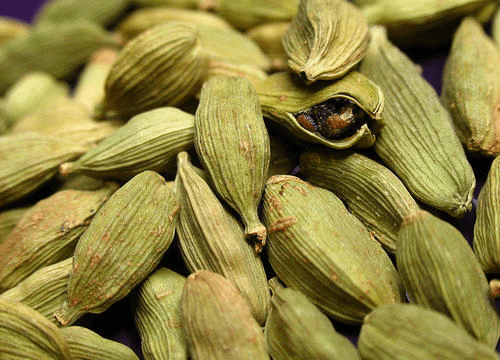 Elettaria cardamomum seeds Cardamom is an aromatic spice used for flavoring, medicinal or masticatory purpose.
Elettaria cardamomum seeds Cardamom is an aromatic spice used for flavoring, medicinal or masticatory purpose.
The plant grows well in warm and humid climate under the shade of trees, with a well distributed rainfall of 150-600 cm and a temperature range of 10-350C. It is grown on well drained rich forest loams and deep red laterite soils with plenty of humus. It thrives best in tropical rain forests at an altitude of 800-1600 m.
Cardamom is propagated vegetatively or from seedlings grown in nurseries and then transplanted. Bulk of the production of cardamom is raised on the hill ranges of Kerala (53%), Karnataka (42%) and Tamilnadu (5%). In Kerala Idukki district produces most of the cardamom followed by palghat, Kozhikode and Cannor. In Karnataka the major areas of cardamom cultivation are Coorg, Hassan and Chikmagalur.
India is the largest producer and exporter of this spice, accounting for 70 percent of total world production and 60 percent of total world trade.
CHILLIES (Capsicum annum)
Also called red 'pepper', it is grown for its pungent fruits, which are used both green and ripe (in dried form) in food. It is also used medicinally, and in chutnies and pickles.
It is grown up to elevations of 1,500 m in areas with moderate rainfall of 60-125 cm and a temperature range of 10-300C. Heavy rainfall and forest affect the crop adversely. The rainfed crop does well on deep, fertile, well-drained black cotton soils and somewhat heavy clayey loams.
Under irrigation and good manuring chilli can also be grown on sandy and light alluvial loams and red loamy soils. It is grown in almost all parts of India. The important producers, however, are Andhra Pradesh, Maharashtra, Karnataka and Tamilnadu, accounting for about 75 percent of total production.
The bulk of chilli produced in India is consumed internally and only a small quantity is exported.
TURMERIC (Curcuma longa)
Turmeric is an important condiment and a useful dye with medicinal values, having varied uses in drug and cosmetic industries. 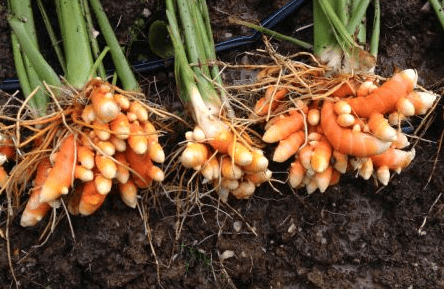 Curcuma longa Turmeric requires a warm humid climate. It is grown as rainfed crop in heavy rainfall areas and under irrigation in other areas. It grows well in well-drained fertile, sandy and clayey, medium black, red or alluvial loamy soils. It is propagated from rhizomes. The harvested rhizomes, separated into smaller pieces, are boiled and dried in the sun before marketing.
Curcuma longa Turmeric requires a warm humid climate. It is grown as rainfed crop in heavy rainfall areas and under irrigation in other areas. It grows well in well-drained fertile, sandy and clayey, medium black, red or alluvial loamy soils. It is propagated from rhizomes. The harvested rhizomes, separated into smaller pieces, are boiled and dried in the sun before marketing.
Turmeric is mostly cultivated in Andhra Pradesh and Tamil Nadu, accounting for 50 percent of country's total annual output. The other states producing turmeric are Bihar, Orissa, Maharashtra, Kerala, Karnataka etc.
Most of the production is consumed internally and only less than 10 percent of the total is exported.
GINGER (Zingiber officinale)
Ginger is cultivated for its aromatic rhizomes which are used both as spice and medicine.
It is cultivated in almost all tropical and sub-tropical parts of the country under heavy rainfall of 125-250 cm or under irrigation. It grows well in deep, well drained friable loams rich in humus.
Ginger is used both as green and dry ginger. Dry ginger or sonth is obtained by cleaning and drying green ginger.
Ginger is largely grown in Kerala accounting for major bulk of the total production. The other producers are West Bengal, Karnataka, Himachal Pradesh, Tamil Nadu, Orissa, Uttar Pradesh, Madhya Pradesh, etc.
Though about 85 per cent of the total production is consumed internally, India is a major exporter of ginger contributing about 40-60 per cent of the total world trade.
Coconut (Cocos Nucifera) 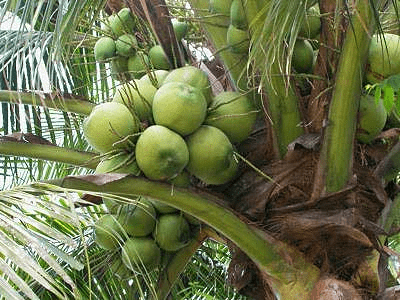 Cocos nucifera India ranks second after Indonesia in the world coconut production. Coconut palm is an important tree providing nuts, timber, fiber and leaves used for an infinite range of purposes. Besides being used for culinary purposes, coconut's most important use is for the manufacture of copra from which oil is extracted which is used for making margarine, vegetable ghee and hard soaps.
Cocos nucifera India ranks second after Indonesia in the world coconut production. Coconut palm is an important tree providing nuts, timber, fiber and leaves used for an infinite range of purposes. Besides being used for culinary purposes, coconut's most important use is for the manufacture of copra from which oil is extracted which is used for making margarine, vegetable ghee and hard soaps.
It is also used as cooking oil, lamp oil and for anointing. Coconut husk is used for the manufacture of coir or coconut fibre. The tree trunks provide timber and shells of nut are used as fuel. Coconut leaves are used for making mats, baskets, screens and even roofs of huts. Water from tender nuts is consumed as a sweet drink. Gur, sugar, toddy and vinegar are made out of the juice collected from coconut spathes. Fresh coconut oil-cake is eaten by poor people and is also used as cattle-feed.
Conditions of Growth: Coconut palm requires humid tropical climate with high temperature and an annual rainfall of 100-225 cm, well-distributed throughout the year. The tree cannot withstand frost and drought. Although it is mainly grown in the coastal plains it can also grow on hill slopes up to 800-1,000 metres height. Coconut thrives best on almost all types of well drained tropical soils such as sandy loams along sea-coasts and in adjoining river valleys, red loams, light grey soils, light black cotton soils, peaty soils and estuarine deposits.
Coconut is a perennial tree which can be propagated only through seeds. The saplings are raised in nurseries before they are transplanted to permanent sites about one year later.
Due to specific growing conditions required by the plant, the coconut cultivation is confined mainly to the coastal belt, only a small production coming from the interior parts of the Peninsula and West Bengal and Assam.
Kerala is the largest producing state, contributing over half of the total annual output, followed by Tamil Nadu, Karnataka, Andhra Pradesh, Goa, Daman and Diu, Maharashtra, Orissa, Andaman and Nicobar Islands, West Bengal and Assam.
ARECANUT (Areca catechu) India is the world's largest producer of arecanut. It is used for chewing with or without betel leaves and lime.
Conditions of Growth: Arecanut palm is essentially a tropical plant which thrives well in regions of heavy well distributed annual rainfall of 180-375 cm and a temperature range of 15-350C. It flourishes well on a wide range of soils like well drained laterite and red soils and clayey loams. It is grown up to an alttitude to 1,000 m. As strong sunshine and torrential rains are harmful to seedlings, they are grown amidst shady trees.
Arecanut is predominantly grown in Assam, Kerala and Karnataka. India has the world's largest area and production of arecanut.
CASHEWNUT (Anacardium occidentale)
Cashew is grown mainly for its nuts although its fruit cashew apple is also used to prepare juice, jam, candy and alcoholic beverages. The cashew nuts contain 47 percent fat, 21 percent protein, 22 percent carbohydrate, minerals and vitamins. As a result cashew stands on per with milk and egg. It is a good appetiser, an excellent nerve tonic, a steady stimulant and controls diabetes.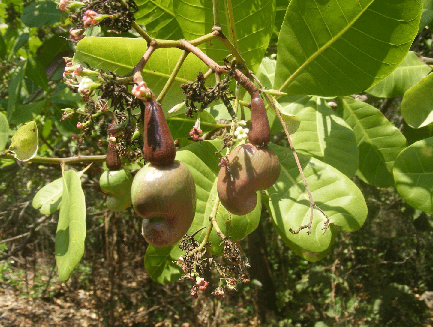 Anacardium occidentaleConditions of Growth: Cashew requires average temperature of 16-250C and a rainfall of 50-400 cm. It flourishes well on poor and rocky soils. On the West coast it is grown on laterite soils while on the East coast it is grown on sandy soils.
Anacardium occidentaleConditions of Growth: Cashew requires average temperature of 16-250C and a rainfall of 50-400 cm. It flourishes well on poor and rocky soils. On the West coast it is grown on laterite soils while on the East coast it is grown on sandy soils.
Cashew is mainly cultivated in the west and east regions. Kerala is the largest producer. It is also grown in Andhra Pradesh, Orissa, Maharashtra, Karnataka, Goa and Tamil Nadu. Some cashew is grown in Tripura, Meghalaya and Madhya Pradesh also. The processing and exporting activities are concentrated in Kerala followed by Tamil Nadu and Karnataka.
India is the largest producer. processor, exporter and second largest consumer of cashew kernels. About 65 percent of world exports of cashew kernels are from India and the US is largest importer.
|
175 videos|472 docs|197 tests
|
FAQs on Plantation Crops - Geography for UPSC CSE
| 1. What are plantation crops? |  |
| 2. Which countries are major producers of plantation crops? |  |
| 3. What are the common types of plantation crops? |  |
| 4. What are the economic benefits of plantation crops? |  |
| 5. Are there any environmental concerns associated with plantation crops? |  |

|
Explore Courses for UPSC exam
|

|


















